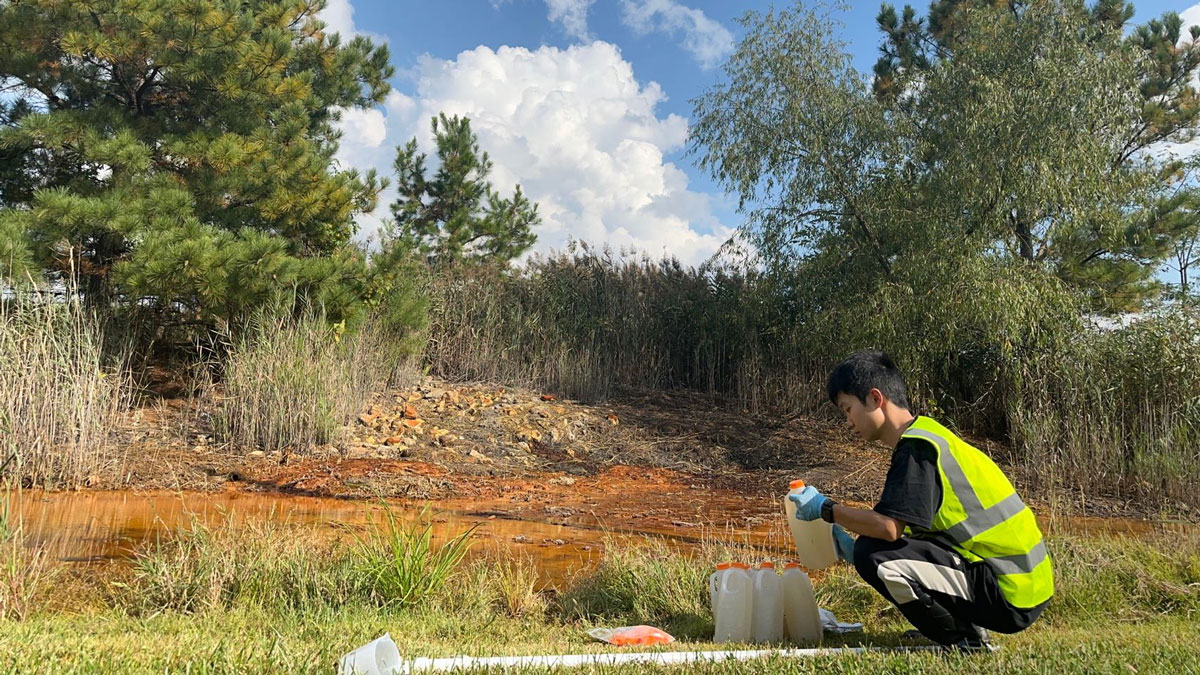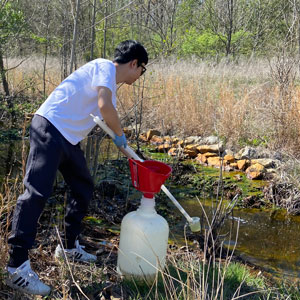
(Above) Partha Protim Bhowmik, a graduate student in civil engineering, collects samples from acid run-off at an abandoned coal mine in Southern Illinois. (Below) Haoran Yang, a doctoral student in engineering science, also collects samples. They and other students are working with Jia Liu, associate professor in the School of Civil, Environmental and Infrastructure Engineering, on a two-year grant of nearly $200,000 from the U.S. Department of Interior to develop ways to salvage rare earth elements from the abandoned coal mine drainages. (Photos provided)
February 06, 2024
SIU experts search abandoned coal mines for rare earth elements used in green energy
CARBONDALE, Ill. – Rare earth elements are key to the energy sources that power many modern technologies, and a Southern Illinois University Carbondale researcher is trying to find ways to glean them from the remnants of yesteryear’s energy source.
Jia Liu, associate professor in the School of Civil, Environmental and Infrastructure Engineering, is using a two-year grant of nearly $200,000 from the U.S. Department of Interior to develop ways to salvage rare earth elements, also called REEs, from the abandoned coal mine drainages dotting the Southern Illinois landscape. The effort aims to develop an economical and environmentally friendly way to separate the valuable elements from a waste product left behind by the area’s once-thriving coal production industry.
Rare, indeed…
Found only in tiny concentrations at particular geologic sites around the world, REEs are used in more than 200 products across a wide range of applications and especially in high-tech consumer products and renewable energy products, such as cellphones, electric and hybrid vehicles, wind turbines and solar panels. The elements also are used in defense applications, including electronic displays, guidance systems, lasers, radar and sonar systems.
 But the elements are hard to come by and access to them can be complicated, as well. About 13% of REE reserves worldwide exist in the United States, so finding new sources of REEs is an important goal for consumers and the government.
But the elements are hard to come by and access to them can be complicated, as well. About 13% of REE reserves worldwide exist in the United States, so finding new sources of REEs is an important goal for consumers and the government.
Scientists have known for decades that acid runoff from mines likely contain varying amounts of REEs. But it wasn't until newer technologies increasing the demand for such elements, combined with geopolitical, global economic and environmental factors, led to finding ways to harvest them from such unconventional sources.
Developing a hybrid technology
Liu’s work will focus on developing a new, specially designed bioelectrochemical system using cathode chambers with a biofilm made from specially selected bacteria formed around the electrodes. Using the environmentally friendly bacteria in this manner is called biosorption, and Liu thinks combining it with electrochemical stimulation will increase its efficiency.
Once the REEs are captured on the biofilms, the process next will use acid to separate them from the films. Liu aims to capture 16 different REEs, including exotic ones such as scandium, yttrium, lanthanum and cerium, among others.
Liu’s previous biosorption tests showed REE recovery rates of around 50%, making her hopeful for even greater success using this hybrid approach.
“We’re trying to provide a laboratory proof-of-concept for this process and our innovative technology,” Liu said. “If we’re successful, our approach will provide a sustainable, environmentally friendly way to recover these valuable resources.”
Work starts in the field
Liu and her students have begun obtaining samples from four abandoned coal mines in the area, measuring certain parameters such as each sample’s acidity level and the amount of dissolved oxygen it contains. They also measure each sample’s conductivity, which gives some indication of the amount of dissolved electrical-conducting elements it contains.
The study group will work in SIU laboratories to develop and perfect the technology, figuring out details such as optimal processing times and acidity levels. If successful, the grant could be extended, and the technology would be a first-of-its-kind REE extraction method that could be implemented in a variety of abandoned mine situations.
“This extraction process can be sustainable and environmentally friendly, which is highly attractive,” Liu said. “We’re hoping to demonstrate a new and economical pathway for valuable REE resource recovery.”
